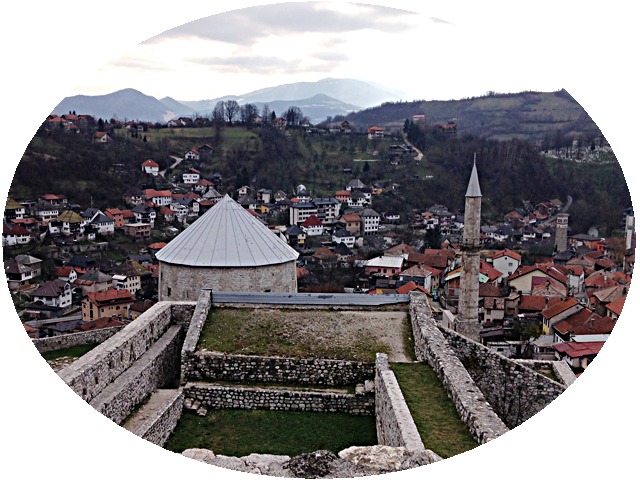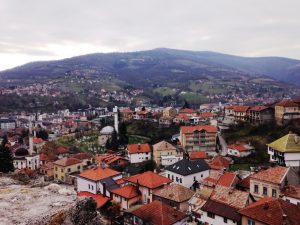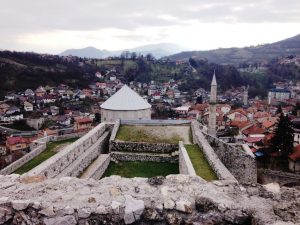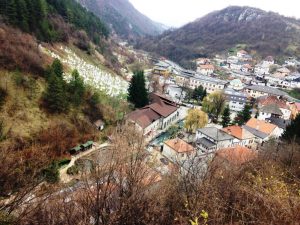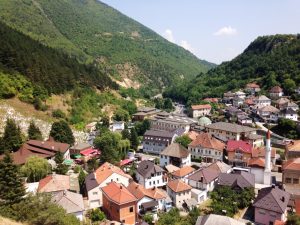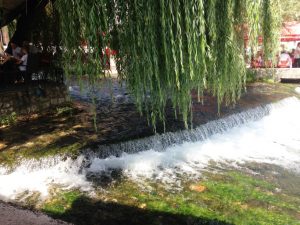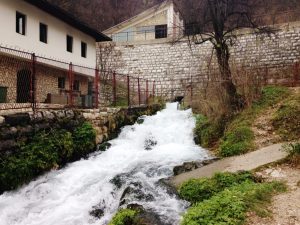Travnik, Bosnia & Herzegovina
Travnik is a town and municipality in central Bosnia and Herzegovina, 90 kilometres west of Sarajevo. It is the capital of the Central Bosnia Canton, and is located in the Travnik Municipality.
Travnik town had 16,534 residents in 2013, with a municipality population that of 57,543 people. It was the capital city of the governors of Bosnia from 1699 to 1850, and has a cultural heritage dating from that period.
History
Although there is evidence of some settlement in the region dating back to the Bronze Age, the true history of Travnik begins during the first few centuries AD. Dating from this time there are numerous indications of Roman settlement in the region, including graves, forts, the remains of various other structures, early Christian basilicas, etc. In the city itself, Roman coins and plaques have been found. Some writing found indicates the settlement is closely connected to the known Roman colony in modern-day Zenica, 30 km (19 mi) away.
In the Middle Ages the Travnik area was known as the župa Lašva province of the medieval Bosnian Kingdom. The area is first mentioned by Bela IV of Hungary in 1244. Travnik itself was one of a number of fortified towns in the region, with its fortress Kaštel becoming today's old town sector. The city itself is first mentioned by the Ottomans during their conquest of nearby Jajce.
After the Ottoman conquest of Bosnia in the 15th century, much of the local population converted to Islam. The city quickly grew into one of the more important settlements in the region, as authorities constructed mosques, marketplaces, and various infrastructure. During 1699 when Sarajevo was set afire by soldiers of Field-Marshal Prince Eugene of Savoy, Travnik became the capital of the Ottoman province of Bosnia and residence of the Bosnian viziers. The city became an important center of government in the whole Western frontier of the empire, and consulates were established by the governments of France and Austria-Hungary.
The period of Austrian occupation brought westernization and industry to Travnik, but also a reduction of importance. While cities such as Banja Luka, Sarajevo, Tuzla, and Zenica grew rapidly, Travnik changed so little that during 1991 it had a mere 30,000 or so people, with 70,000 in the entire municipality.
A large fire started by a spark from a locomotive in September 1903 destroyed most of the towns buildings and homes, leaving only some hamlets and the fortress untouched.[2] The cleanup and rebuilding took several years.[3]
From 1929 to 1941, Travnik was part of the Drina Banovina of the Kingdom of Yugoslavia.
During the Bosnian War, the town mostly escaped damage from conflict with Serbian forces, hosting refugees from nearby Jajce, but the area experienced fighting between local Bosniak and Croat factions before the Washington Agreement was signed in 1994. After the war, Travnik was made the capital of the Central Bosnia Canton.
Climate
Travnik has a continental climate, located between the Adriatic sea to the South and Pannonia to the North. Average summer temperature is 18.2 °C (64.8 °F). Average winter temperature on the other hand is a cold 0.5 °C (32.9 °F). It snows in Travnik every year.
Area: 35 km²
Tourism


